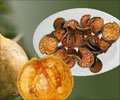Summertime is for hiking and camping, but it brings with it the risk of tick bites and Rocky Mountain spotted fever.
Summertime is for hiking and camping, but it brings with it the risk of tick bites and Rocky Mountain spotted fever. In order to prevent such illnesses, researchers are looking at the role played by antioxidants like alpha-lipoic acid and green tea and vitamins C and E in preventing infection by rickettsia bacteria.
The National Institute of Allergy and Infectious Disease, part of the National Institutes of Health, awarded the University of Rochester Medical Center $2 million for a five-year study of the antioxidant theory. The grant caps more than a decade of rickettsia research led by Sanjeev Sahni, Ph.D.Rocky Mountain spotted fever is the most frequently reported illness in the United States caused by the rickettsia bacteria, which is transmitted by tick parasites. It usually afflicts otherwise healthy adults and children who are bitten by wood ticks or dog ticks. The illness can become life threatening if left untreated, and spotted fever can be difficult for physicians to diagnose because the earliest signs mimic less-serious viral illnesses. Limiting exposure to ticks is the best way to prevent the disease. If it does develop, in most cases doctors can treat it with antibiotics. Typhus is another rickettsial disease spread by lice or fleas. Although less common, typhus remains a threat in crowded jails and in other poor hygienic environments.
"Our studies have the potential to identify novel therapeutic targets for a host of rickettsial diseases," said Sahni, an assistant professor in Hematology/Oncology at the University of Rochester.
Dr. Howard Taylor Ricketts, who eventually died of typhus, identified rickettsia in the late 1800s. Sahni's research group first began investigating the rickettsia bacteria as a model to study the biological changes that occur in the lining of the blood vessels (endothelium) as the bacteria travels through the blood stream. Initially they were looking at what types of cellular changes occur in response to the infection. They discovered that cells undergo oxidative stress and produce harmful free radicals, causing inflammation and other complications.
Researchers hypothesized that antioxidants might serve as useful therapies after examining the damage to infected cells, as seen by electron microscopy, and through biochemical evidence proving oxidative stress (OS), a term used to describe a level of damage in cells, tissue and organs. Antioxidants can generally neutralize free radicals and reduce oxidative damage. Earlier experiments in which scientists infected cells with rickettsia bacteria and then treated the cells with alpha-lipoic acid, a powerful antioxidant, showed that the infected cells did, indeed, marshal a defense against the bacteria.
Sahni is also investigating what enzymes might boost antioxidants to work more efficiently. His group is studying the process that occurs when infected cells express cyclooxygenase (Cox-2) and prostaglandins, which results in inflammation. This biological process is what causes the severe swelling in the limb that was bitten by a tick harboring the rickettsia bacteria. Sahni theorizes that regulating the Cox-2 response with Cox-2 inhibitors such as ibuprofen could also help control the disease.
Advertisement











